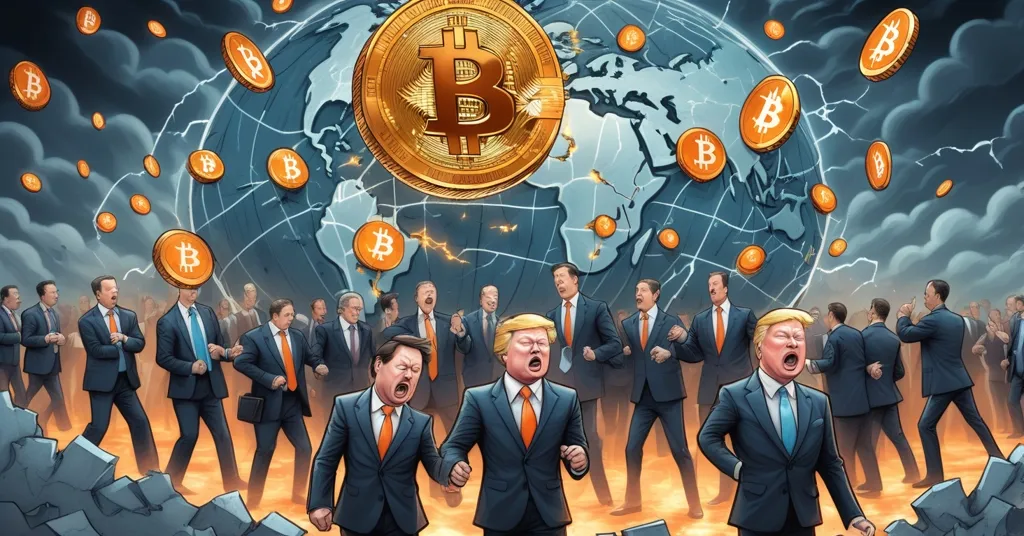Trump’s Economic Chaos at ECB Summit: Is Bitcoin the Ultimate Hedge?

Trump’s Return Rocks Global Economy at ECB Summit: Is Bitcoin the Lifeboat?
Five months into Donald Trump’s second presidency, the world’s financial leaders are sweating bullets at the European Central Bank’s (ECB) annual retreat in Sintra, Portugal. What was meant to be a strategic powwow on monetary policy turned into a frantic scramble to address the chaos unleashed by Trump’s tariffs, trade wars, and unpredictable economic maneuvers. With central banks paralyzed and global markets on edge, could decentralized systems like Bitcoin and blockchain technology offer a way out of this mess?
- Trump’s Chaos Dominates: ECB Summit sidelined by U.S. tariffs and trade unpredictability.
- Central Banks Frozen: Fed, ECB, and others halt rate decisions amid economic turmoil.
- Crypto’s Rising Appeal: Bitcoin and DeFi position as hedges against fiat instability.
Trump’s Economic Wrecking Ball
The atmosphere in Sintra was tense, to say the least. Heavyweights like Federal Reserve Chair Jerome Powell, ECB President Christine Lagarde, Bank of England Governor Andrew Bailey, Bank of Japan’s Kazuo Ueda, and Bank of Korea’s Rhee Chang-yong gathered for a public panel. Normally, they’d be hashing out coordinated plans to tackle inflation or spur growth. Instead, they were playing whack-a-mole with the fallout from Trump’s latest policy bombs. Powell made it clear the Fed isn’t rushing into interest rate cuts, pointing to cooling U.S. consumer spending and sticky core inflation as reasons to hold off. Lagarde signaled the ECB, fresh off a recent rate cut, isn’t planning more reductions anytime soon. The Bank of England hit pause, Japan’s central bank won’t budge before July 31 at the earliest, and South Korea is tiptoeing with similar caution, as highlighted in discussions at the ECB Sintra summit on Trump’s policy impacts.
For those new to this financial circus, central banks are the big dogs controlling a nation’s money supply. They tweak interest rates to keep prices (inflation) in check or to boost or slow the economy. A “pause” on rate decisions means they’re sitting tight, often because the future looks murkier than a foggy swamp. Trump’s policies are that swamp. His tariffs—taxes slapped on imported goods—jack up costs for everyone, fueling price hikes worldwide. His knee-jerk trade moves, like slamming the brakes on talks with Canada over a 3% digital services tax targeting U.S. tech giants (those pulling in over C$20 million in revenue), send shockwaves through supply chains. No wonder central banks are stuck in neutral, waiting for the next White House tweet-storm to blow up their plans. More on this tension can be found in recent updates on the U.S.-Canada digital services tax conflict.
This isn’t just a gut punch from a few policy shifts. Research from the Centre for Economic Policy Research (CEPR) reveals Trump has signed over four times more Executive Orders by mid-May 2025 than in the same stretch of his first term (2017-2021). Tariffs have skyrocketed from an average of 2.3% under Biden to a hefty 10% now. His confrontational style—described as boundary-testing and brinkmanship—has even prompted Supreme Court Chief Justice Roberts to warn of an “endangered” rule of law. The CEPR paints a bleak picture: a potential U.S. recession in 2025, consumer confidence tanking (Americans expect 7% inflation while models predict 3%), and a slow unraveling of the multilateral economic order that’s held since the Cold War. This isn’t a hiccup; it’s a full-blown fracture, as detailed in a preliminary assessment of Trump’s second-term economic policies.
Global Ripple Effects: A World on Edge
The damage isn’t limited to conference rooms in Portugal or boardrooms in the U.S. Asia’s economic signals are flashing red. China’s Purchasing Managers’ Index (PMI)—think of it as a health check for factories—is set to show a third straight month of shrinking production. Similar dismal reports are expected from South Korea, Malaysia, Vietnam, Indonesia, the Philippines, and Taiwan. Japan offers a faint glimmer with its Tankan survey predicting a 10% bump in big company investments, but that’s a drop in the bucket against deflationary pressures and trade spats worsened by U.S. moves, a situation further explored in coverage of Trump’s destabilizing effect on global economic policy.
Across the Atlantic, Latin America is catching strays. Argentina’s first-quarter growth flopped, Chile is holding rates steady despite the global mess, and Colombia got slapped with credit downgrades from S&P Global Ratings and Moody’s over fiscal rule suspensions and mounting debt. Even Turkey, with inflation expected to dip slightly to around 35%, is mulling a significant rate cut out of sheer desperation rather than confidence. In Europe, euro-zone inflation is pegged at 2%, with small upticks in Germany and Italy, while Switzerland might see a rare drop. But as ECB Chief Economist Philip Lane put it before the summit:
“You do need to step back, rather than just talk about ‘what are we going to do in July or September?’ to look at the underlying forces.”
He called the panel “a very lively session,” which is probably code for “a total cluster.” A Bloomberg economist, Stuart Paul, summed up the Fed’s tightrope act:
“Quickening core inflation and slowing spending will keep the Fed uneasy, fueling debate about the appropriate number of rate cuts this year.”
In short, Trump’s policy roulette has the world’s economies spinning—and not in a good way, a point reiterated in reports on the global economic impact of Trump’s return at the ECB Summit.
Crypto as a Counterweight: Bitcoin and Beyond
Here’s where things get interesting for us decentralization junkies. With fiat currencies and traditional financial systems buckling under this political mayhem, Bitcoin and blockchain tech start looking less like nerdy side hustles and more like viable escape hatches. Bitcoin, often dubbed digital gold, shines in times of turmoil. Its capped supply of 21 million coins means no government can print more to devalue it—unlike the dollar, which gets shaky when inflation fears spike (like that 7% consumer expectation in the U.S.). When trust in centralized money erodes, BTC becomes a go-to store of value. Just look at past trade wars with China during Trump’s first term—Bitcoin’s price often surged as a hedge against uncertainty, a perspective shared in community discussions on Bitcoin as a safeguard against tariffs.
Then there’s Decentralized Finance (DeFi), built on blockchains like Ethereum. DeFi lets you cut out the middleman—banks, bureaucrats, you name it. Need to lend money to a supplier in Vietnam hit by U.S. tariffs? Do it directly via a DeFi app on the blockchain. Want to pay for goods without worrying about trade barriers? Use a smart contract, which is just a self-running agreement coded to execute automatically when terms are met (think of it as a vending machine for finance—insert conditions, get results). Small businesses in places like Mexico, squeezed by Trump’s trade policies, could turn to blockchain for transparent, borderless supply chain payments. It’s not sci-fi; pilot projects are already live in some regions, with insights on this potential explored on how DeFi can address trade disruptions.
Europe’s angle adds fuel to this fire. The CEPR suggests Trump’s antics might push the EU toward “strategic autonomy,” beefing up its own digital infrastructure. If that includes blockchain, we could see decentralized tech become a pillar of regional resilience, sidestepping reliance on U.S.-dominated financial systems. Hell, even humanitarian aid—cut drastically by Trump’s policies, potentially leading to hundreds of thousands of deaths in low-income nations per CEPR—could pivot to crypto for direct, censorship-resistant transfers. Blockchain doesn’t care about political whims, a dynamic further analyzed in discussions on Bitcoin’s role during financial instability under Trump.
Reality Check: Crypto Isn’t a Magic Fix
Before we start chanting “Bitcoin fixes everything,” let’s pump the brakes. Crypto isn’t a silver bullet—it’s more like a rusty shotgun. Bitcoin’s price can swing wilder than a pendulum on steroids; just recall the 2022 bear market when it tanked over 60% in months. That volatility scares off mainstream adoption faster than a shady ICO pitch. Scalability is another headache—BTC handles a measly 7 transactions per second compared to Visa’s thousands. It’s nowhere near ready to replace global trade systems overnight, even as some look to historical data on tariffs under Trump’s second term for context on economic pressures.
Altcoins and DeFi have their own baggage. Ethereum powers killer apps with smart contracts, but it’s been hit by hacks—think of the $320 million Wormhole bridge exploit in 2022. Regulatory crackdowns loom large too; governments spooked by Trump’s economic mess might double down on strangling decentralized tech with red tape. And let’s not even start on the scammers flooding the space with promises of 100x gains. We’ve got zero tolerance for that garbage here. If crypto wants to be a serious player in this crisis, it needs real utility, not hype-driven nonsense peddled by grifters on X. Scrutiny, not blind faith, is our best tool.
Looking Ahead: Decentralization’s Big Moment?
The Sintra summit exposed a global economy held hostage by one man’s erratic playbook. From Asia’s crumbling factory output to Latin America’s fiscal woes, the dominoes are falling. Central banks, supposed guardians of stability, are twiddling their thumbs while Trump spins the wheel of chaos. Yet in this upheaval, there’s a spark of opportunity for those of us rooting for a financial revolution. Bitcoin and blockchain embody the decentralization, freedom, and disruption of a rotten status quo that we stand for. If Trump keeps swinging his policy wrecking ball, he might just fast-track the case for mass crypto adoption—whether he means to or not.
But we’re not naive. The road to a decentralized future is paved with potholes—volatility, tech limitations, and regulatory landmines. Still, the cracks in centralized finance are widening, and blockchain could be the wedge that splits them open. As champions of effective accelerationism, we say let’s push this change hard and fast, but with eyes wide open. The future of money is up for grabs, and we’re not here to play nice with a broken system.
Key Questions and Takeaways on Trump’s Policies and Crypto’s Role
- How Are Trump’s Tariffs Shaking Up Global Finance and Boosting Bitcoin’s Appeal?
Trump’s tariffs and erratic trade policies are spiking inflation and stalling central bank decisions, creating turmoil that makes Bitcoin a compelling hedge against fiat uncertainty and a store of value when trust in traditional money falters. - Can Decentralized Finance (DeFi) Offset Trade Disruptions from U.S. Policies?
DeFi offers borderless tools like direct lending and payments on blockchain, bypassing trade barriers, but scalability issues and regulatory risks mean it’s not a full solution yet. - Why Does Central Bank Hesitancy Fuel Interest in Cryptocurrencies?
With institutions like the ECB and Fed paralyzed by economic chaos, distrust in centralized systems grows, pushing people toward crypto for autonomy and stability, though mainstream confidence remains shaky. - What Hurdles Does Crypto Face in This Economic Storm?
Despite its potential, crypto battles brutal price swings, protocol vulnerabilities, and the threat of government crackdowns, all of which could derail adoption even as the need for decentralization screams louder.



